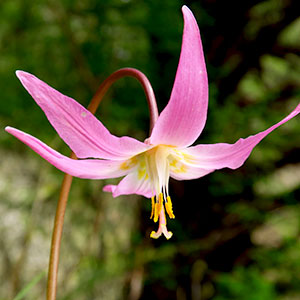Erythronium revolutum
Erythronium albidum
coast fawn lily, mahogany fawn lily, pink fawn-lily
white fawnlily, white trout-lily
narrowly ovoid, 35–50 mm, sometimes producing sessile offsets.
ovoid, 15–30 mm;
stolons 1–3, mostly on 1-leaved, nonflowering plants; flowering plants reproducing vegetatively by offshoots or droppers.
10–25 mm;
blade distinctly mottled with irregular streaks of brown or white, broadly lanceolate to ovate, margins entire to ± wavy.
8–22 cm;
blade green, irregularly mottled, elliptic-lanceolate to ovate-lanceolate or elliptic, ± flat, glaucous, margins entire.
15–40 cm.
7–20 cm.
1–3-flowered.
1-flowered.
tepals uniformly clear violet-pink at anthesis, with yellow banding at base, lanceolate to narrowly elliptic, 25–40 mm, inner with small auricles at base;
stamens ± appressed to style, 12–22 mm;
filaments white to pink (darkening with age), flattened, ± lanceolate, 2–3 mm wide;
anthers bright yellow;
style white to pink, 12–18 mm;
stigma with slender recurved lobes 4–6 mm.
tepals strongly reflexed at anthesis, white, tinged pink, blue, or lavender abaxially, with yellow adaxial spot at base, lanceolate, 22–40 mm, auricles absent;
stamens 10–20 mm;
filaments yellow, lanceolate;
anthers yellow;
pollen yellow;
style white, 15–25 mm;
stigma lobes recurving, 1.5 mm.
oblong to obovoid, 3–6 cm.
held erect at maturity, obovoid, 10–22 mm, apex rounded to faintly apiculate or umbilicate.
= 44.
Erythronium revolutum
Erythronium albidum
Erythronium albidum often forms extensive colonies in which nonflowering, 1-leaved plants far outnumber flowering, 2-leaved ones. It is very widespread in eastern North America, more common in the central states than E. americanum and often occurs in slightly drier sites.
(Discussion copyrighted by Flora of North America; reprinted with permission.)
- Local floras:
BC,
CA,
OR,
WA
- Local Web sites:
CalFlora,
CalPhotos,
Flora NW,
PNW Herbaria,
Turner Photog.
WildflowerSearch
iNaturalist (observations)
USDA Plants Database
- LBJ Wildflower Center
- SEINet
- Plants of the World Online
- Encyclopedia of Life
- Wikipedia
- Google Image Search


